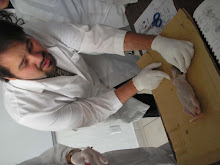To know what that is we need to understand what ions are: The elements that have charges, there are two types: Cations (positive) and Anions (negative).
Now to get there we need to discuss metals and nonmetals.
"Atoms of metals tend to lose their electron valances leaving a complete octect in the next energy level."
Which basically tells you that metals tend to give up electrons.
Example: Na (z=11) configuration= 1s22s22p63s1which means it has 1 valance electron, and in order to be like a noble gas it has to lose one electron by doing this the atom goes from neutral to positive because now it has more protons than electrons. So it becomes a cation of sodium, because when they become cations they don't change the name.
-When you look at the periodic table: the number in the top right corner with the negative and positive charge tells you how many electrons ot gives or takes away and whether it becomes a positive or negative charge.
You can also look at he columns (1a, 2a, 3a, etc.) to know how many it loses.
Once an atom becomes a cation or anion it becomes different than the original even if it's a small different it can cause a lot of changes.
"Atoms of nonmetals tend to gain electrons or to share electrons with another nonmetal to achive an octet."
When an atom becomes an anion you change the name by replacing the last syllable with -ide.
ex: Chlorine -> Chloride.
Now the best way to know if it loses or gains electrons is by looking at it's valance number:
if it's 1-3 it loses
if it's 5-7 it gains
if it's 4 then it's a metalloid and it can do either, lose or gain.
If you've paid attention you've realized that despite me saying we were going to talk about ionic bonds I have yet to say anything about them, that's because you need to know evrything I've just said before you understand what's next.
Ionic Bond is held together by electrostatic forces.
Metal cation + Nonmetal anion = Neutral compound
(+) (-)
Ex:
Na (+1) + Cl (-1) = NaCl
(P.S. Cations always go first it would never be written ClNa)
That was the whole class, and there was no homework.



